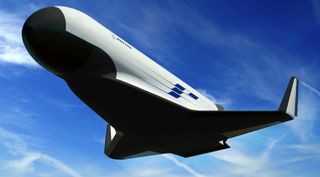Why DARPA Is Pursuing the Reusable Military XS-1 Spaceplane

ORLANDO, Fla. – Here's a phrase that's not repeated everyday in the space community:
"You've heard Elon's comments … we want to go beyond that," Brad Tousley, the head of the tactical technology office at the Defense Advanced Research Projects Agency, said May 15.
Elon, of course, is Elon Musk, the optimistic, and some say visionary, founder of SpaceX with plans of eventually colonizing Mars. After landing three first-stage rockets, Musk has said SpaceX would inspect the rockets with plans to later re-fly most of them. [DARPA's XS-1 Military Space Plane Concept in Pictures]
Tousley oversees DARPA's space programs, which often handles the Defense Department's most difficult development challenges. He described the landing of first stage rockets by SpaceX and Blue Origin as "very, very impressive accomplishments."
But during a speech at the GEOINT 2016 conference here, Tousley said the agency's experimental spaceplane, known as XS-1, also has ambitious plans.
"We want to launch again in 24 hours," he said.
Ideally, DARPA's XS-1 spaceplane would launch 10 times in 10 days and carry payloads weighing as much as 1,360 kilograms into low earth orbit for $5 million.
Get the Space.com Newsletter
Breaking space news, the latest updates on rocket launches, skywatching events and more!
DARPA is finalizing a request for proposals for the second phase of the XS-1 development program. The agency could release that acquisition document as early as this month, DARPA officials have said. A contract award, as part of a public-private partnership, could come as early as 2017 with the first flight tests in 2020.
Tousley said DARPA would contribute "a healthy fraction" to the development of the spaceplane. XS-1 has been the agency's top-funded space program the last two years. The White House asked for $50 million for the program in its budget request for fiscal year 2017.
Three industry teams have worked on the first phase of the program: Boeing and Blue Origin; Masten Space Systems and XCOR Aerospace; and Northrop Grumman and Virgin Galactic.
But during his speech here Tousley emphasized the importance of the quick turnaround for the spaceplane.
"One of the critical parameters that's coming out of the Phase 2 solicitation for XS-1 is the requirement that before we launch this asset for the first time, the vendors are going to prove to DARPA through a ground test of their propulsion system 10 times in 10 days," he said. "We're going to burn a lot of risk down."
Tousley said XS-1 may also act as a deterrent for the Defense Department as threats to national security satellites have emerged in recent years.
"If you have the ability to launch an asset in 24 hours, essentially on a moment's notice, then it may cause an adversary to think twice about exactly what it is they want to do from a threatening standpoint," he said. "We think just having that capability as being of a deterrent value."
This story was provided by SpaceNews, dedicated to covering all aspects of the space industry.
Join our Space Forums to keep talking space on the latest missions, night sky and more! And if you have a news tip, correction or comment, let us know at: community@space.com.
Mike Gruss is a veteran defense reporter and Editor-in-Chief of Sightline Media Group, which includes Army Times, Air Force Times, Dense News, Military Times and Navy Times. From 2013 to 2016, Mike served as a Senior Staff Writer for SpaceNews covering national security space programs and military space policy in the U.S. Congress. Mike earned a bachelor's degree in English and American Studies from Miami University and has previously wrote for the Journal Gazette in Fort Wayne, Indiana and the Virginian-Pilot in Virginia before joining SpaceNews. Prior to joining Sightline in 2017, he was a senior editor of FedTech magazine covering technology in federal government. You can see Mike's latest project on Twitter.

